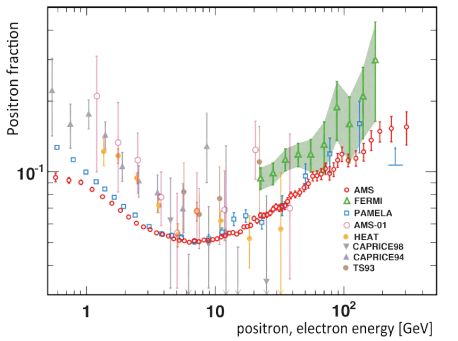Mysterious and invisible dark matter is still mysterious, but possibly a little less invisible after hints of its existence were announced at CERN yesterday, in a cautious but read-between-the-lines-nudge-nudge-wink-wink presentation.
The Alpha Magnetic Spectrometer (AMS) experiment, led by Professor Samuel Ting – who won the Nobel Prize in Physics in 1976 for his part in the discovery of the J/ψ meson and hence the charm quark – confirmed that there are more positrons in space than you’d expect, and this could be due to dark matter. Of course, it could also be due to something else, but Professor Ting sounds like he’s betting on dark matter.

What AMS did was look at cosmic rays, which are charged particles that zip through outer space, and which would likely kill us all if we weren’t protected by Earth’s atmosphere and magnetic field.
Based on the International Space Station, AMS uses magnets and other clever devices to measure the electric charge, energy and momentum of the cosmic ray particles and so work out what they are.
In particular, it looked at the ratio of electrons to anti-electrons, known as positrons (because they have positive charge). The universe is full of electrons, but positrons are generally only produced when other particles interact. This means that there should be fewer positrons at higher energies, as there are fewer parent particles at higher energies to create them.
But AMS found that although there is a dip at an energy of around 10 GeV, after that the proportion of positrons increases. So something is creating more positrons at higher energies.
This could be dark matter, which many people believe to be WIMPs, short for weakly interacting massive particles. These particles would interact via the weak nuclear force, as do electrons and positrons. So if a WIMP and an anti-WIMP happen to collide (or possibly if WIMPs are there own anti-particles), they would produce an electron-positron pair.
The numbers of positrons produced would then be expected to rise until you reach the energy corresponding to the mass of the WIMPs (E=mc2), after which they’d suddenly drop off. This would be a good sign that what we’re looking at is indeed due to dark matter.
If not, it could be something else in the universe, like a pulsar. However, the signal that AMS found appears to be coming from all directions, so that seems unlikely. But then it’s still possible that it’s being produced by something else that astrophysicists don’t know about. Which would also be cool.

So what are we seeing? Well, at the moment we’re just seeing the number of positrons rise with higher energy, but levelling off at around 350 GeV. Beyond that, the AMS team haven’t detected enough positrons to say. There were only 72 found at 350 GeV, and the fewer there are the greater the statistical uncertainty. Professor Ting’s demeanour hinted that he has an idea about what might be found at the higher energies, but he refused to be drawn.
This is admirable restraint, which actually shouldn’t be that surprising coming from a guy who won a Nobel Prize for experimental physics. But these days there’s often a tendency to call a press conference as soon as there’s even a hint of an exciting discovery, which then evaporates as more data comes in. Remember those faster-than-light neutrinos?
So it makes sense that Professor Ting is being cautious by refusing to release “preliminary results”, and saying he’ll only make an announcement when they’re statistically confident they have something. Plus as he pointed out, doing experiments in space is very difficult, so it takes time to get it right. And since he’s been working on this for 18 years, he’s prepared to wait a little longer.
As for what any WIMPs actually are, that’s up to the theoretical physicists to work out. And it has to be compatible with what’s being found – or rather, not being found – at the Large Hadron Collider at CERN.
But whatever is the origin of the signal seen by AMS, it’s likely to be something new to physics, which is exciting. And considering the last big announcement from CERN was that the Higgs boson is probably really the Higgs boson, we could do with some new physics.
We just have to wait until Professor Ting is ready to tell us.
(This story aired on 18 April 2013 – you can listen to the podcast.)
There has been a recent confirmation:
Interesting idea. If dark matter does give off radiation – even just electron-positron pairs – maybe it really is grey matter after all.